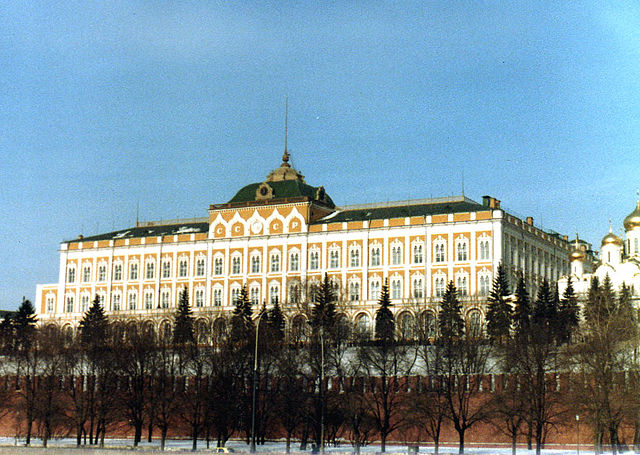Top Qs
Timeline
Chat
Perspective
Supreme Soviet of the Soviet Union
Highest legislative body of the Soviet Union (1938–1991) From Wikipedia, the free encyclopedia
Remove ads
The Supreme Soviet of the Union of Soviet Socialist Republics (SSUSSR)[a] was the highest organ of state authority of the Soviet Union from 1936 to 1991. Based on the principle of unified power, it was the only branch of government in the Soviet state, and headed the unified state apparatus.
Prior to 1936,[3] the Congress of Soviets was the highest organ of state authority. During 1989–1991 a similar, but not identical organ acted as the highest organ of state authority. The Supreme Soviet appointed the Council of Ministers, the Supreme Court, and the Procurator General of the Soviet Union as well as elected the Presidium which served as the Soviet Union's collective head of state under both the 1936 and 1977 Soviet Constitutions.[3]
By the Soviet constitutions of 1936 and 1977, the Supreme Soviet was defined as the highest organ of state power in the Soviet Union and was imbued with great lawmaking powers. In practice, however, it was a rubber stamp parliament which did little more than ratify decisions already made by the Soviet Union's executive organs and the Communist Party of the Soviet Union (CPSU) – always by unanimous consent[3] – and listen to the General Secretary's speeches.[3] This was in accordance with the Stalinist CPSU's principle of democratic centralism and became the norm for other Communist legislatures.
Remove ads
History
This section needs expansion. You can help by adding to it. (September 2025) |
The Supreme Soviet of the Soviet Union (Верхо́вный Сове́т СССР, Verkhovny Sovet SSSR) was the highest legislative body in the Soviet Union from 1938 to 1991. It succeeded the Congress of Soviets of the Soviet Union and functioned as the nominal supreme organ of state power according to the 1936 Soviet Constitution.
Structure
The Supreme Soviet replaced the Congress of Soviets in 1938 and was theoretically the highest authority in the USSR. In practice, however, it usually rubber-stamped decisions made by the Communist Party and its Politburo.
Originally, it was composed of two chambers of equal legislative power:
- The Soviet of the Union – representing the general population, elected based on equal population representation.
- The Soviet of Nationalities – representing the various nationalities of the USSR, with seats apportioned to each republic and autonomous entity.
Although the Supreme Soviet was formally the highest organ of state power, real authority rested with the Communist Party until Mikhail Gorbachev's reforms in the late 1980s. Under perestroika, it became a somewhat genuine parliamentary body after the creation of the Congress of People's Deputies of the Soviet Union in 1989, from which the Supreme Soviet was elected as a smaller working legislature.
The last session of the Supreme Soviet was held in December 1991, shortly before the formal dissolution of the USSR.
Remove ads
Powers
The Supreme Soviet had authority to:
- Enact laws and amend the Constitution of the Soviet Union.
- Elect the Presidium of the Supreme Soviet, which acted as a collective head of state between sessions.
- Appoint the Council of Ministers (executive branch).
- Ratify international treaties and approve economic plans.
Sessions were generally short, held twice a year, with most legislative work done by standing commissions or the Presidium.
Presidium
Between sessions, its powers were exercised by the Presidium of the Supreme Soviet, which could issue decrees (ukazy) with the force of law, subject to later approval.
See also
References
External links
Structure
Leaders
Convocations
Supreme Soviets of the republics
See also
Notes
References
Further reading
External links
Wikiwand - on
Seamless Wikipedia browsing. On steroids.
Remove ads




